English Medium Instruction and Teacher Development: A Review
VerifiedAdded on 2023/03/31
|43
|11932
|167
Literature Review
AI Summary
This literature review examines the factors that influence the ability of English Medium Teachers to effectively deliver the mainstream curriculum to English as an Additional Language (EAL) learners, specifically within the context of Abu Dhabi. The review explores key areas such as teacher self-efficacy, the implementation of English Medium Instruction (EMI), and the importance of professional development. It delves into various theories of second language acquisition, including Behaviorism, Constructivism, Social Interactionism, and Nativism, and discusses how factors like age and attitude impact language learning. The paper analyzes the impact of age, attitude and other factors on the development of second language acquisition. The paper synthesizes research from various scholars, journals, and academic articles to provide a comprehensive overview of the topic, highlighting the challenges and opportunities faced by teachers in supporting EAL students within the Abu Dhabi educational system. The review underscores the importance of teacher training and the development of strategies to improve language teaching and curriculum delivery.
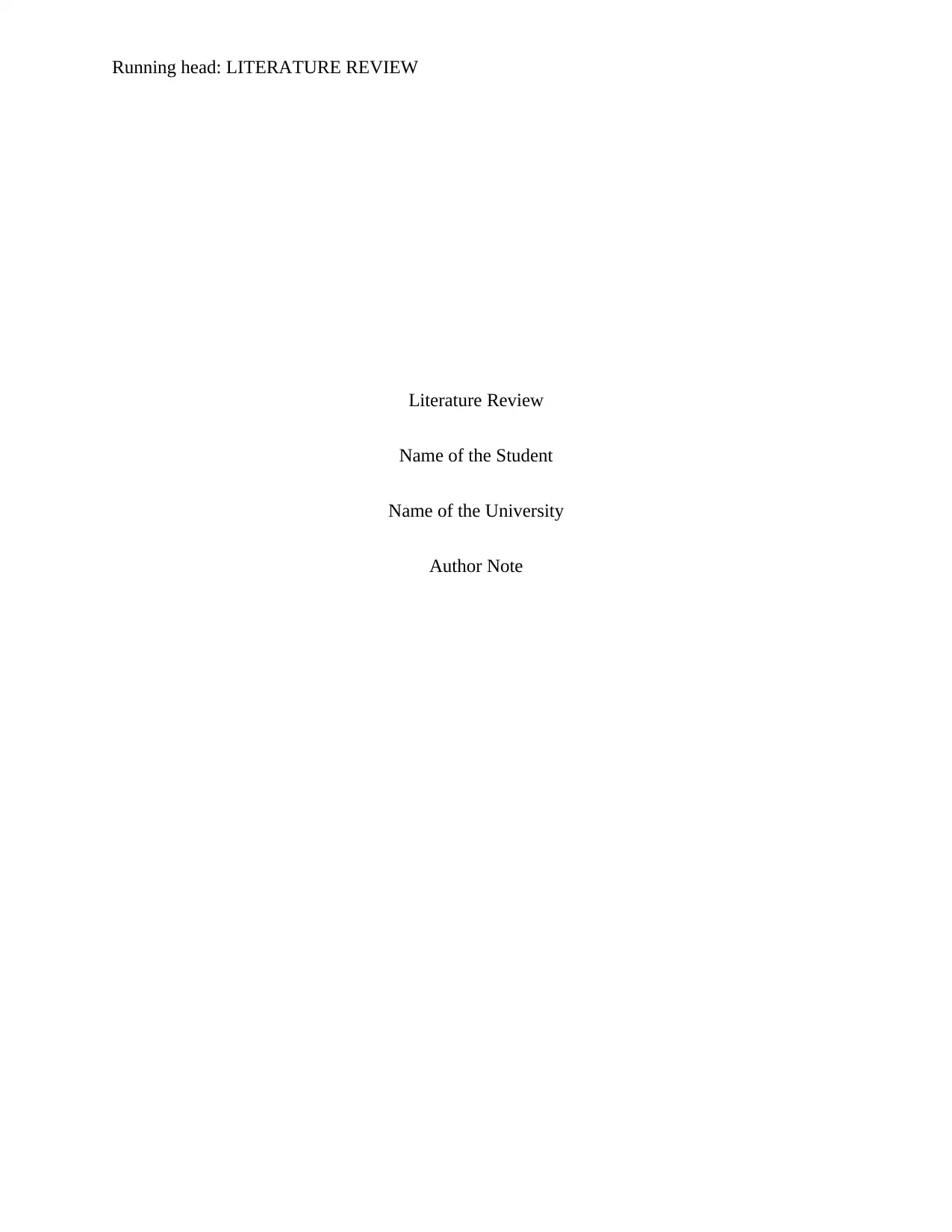
Running head: LITERATURE REVIEW
Literature Review
Name of the Student
Name of the University
Author Note
Literature Review
Name of the Student
Name of the University
Author Note
Paraphrase This Document
Need a fresh take? Get an instant paraphrase of this document with our AI Paraphraser
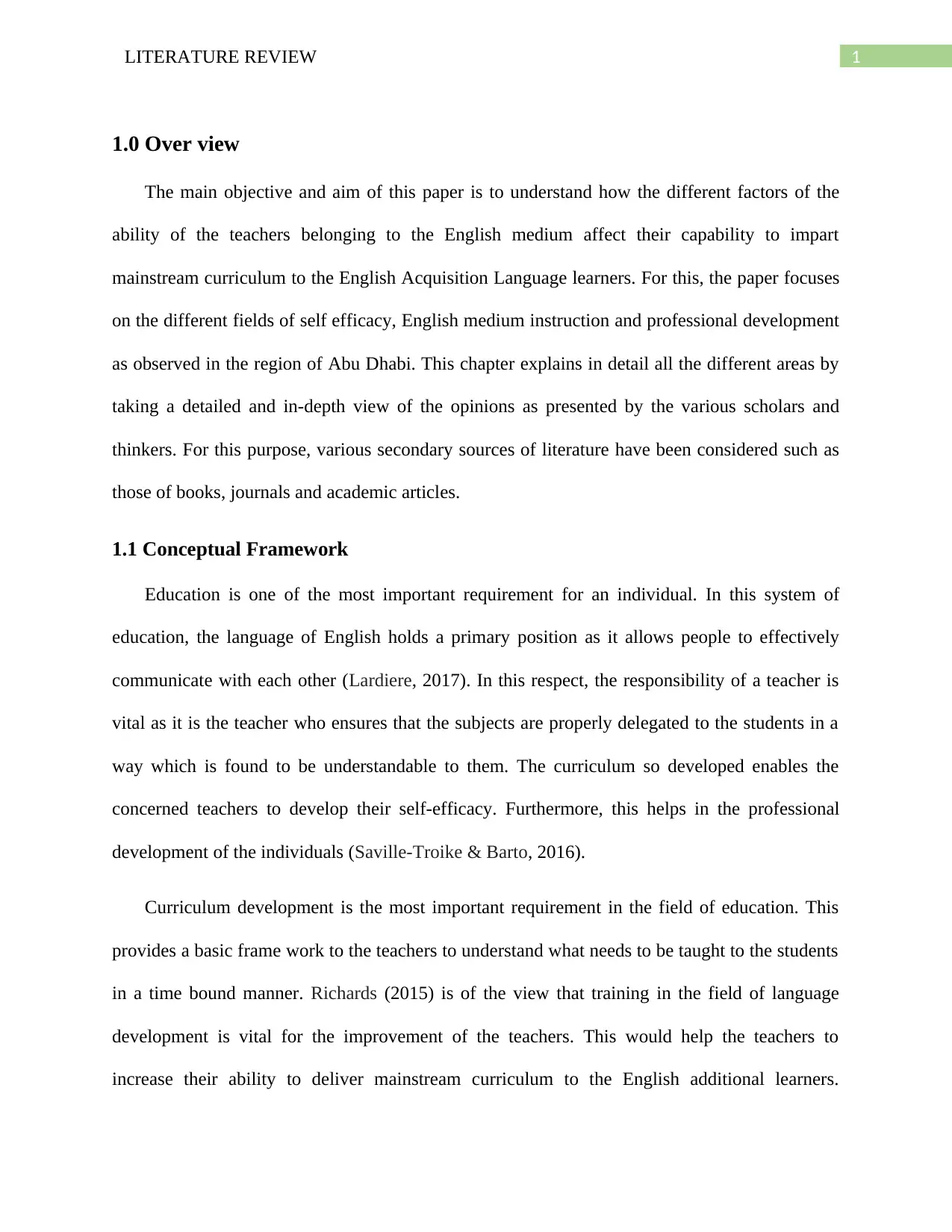
1LITERATURE REVIEW
1.0 Over view
The main objective and aim of this paper is to understand how the different factors of the
ability of the teachers belonging to the English medium affect their capability to impart
mainstream curriculum to the English Acquisition Language learners. For this, the paper focuses
on the different fields of self efficacy, English medium instruction and professional development
as observed in the region of Abu Dhabi. This chapter explains in detail all the different areas by
taking a detailed and in-depth view of the opinions as presented by the various scholars and
thinkers. For this purpose, various secondary sources of literature have been considered such as
those of books, journals and academic articles.
1.1 Conceptual Framework
Education is one of the most important requirement for an individual. In this system of
education, the language of English holds a primary position as it allows people to effectively
communicate with each other (Lardiere, 2017). In this respect, the responsibility of a teacher is
vital as it is the teacher who ensures that the subjects are properly delegated to the students in a
way which is found to be understandable to them. The curriculum so developed enables the
concerned teachers to develop their self-efficacy. Furthermore, this helps in the professional
development of the individuals (Saville-Troike & Barto, 2016).
Curriculum development is the most important requirement in the field of education. This
provides a basic frame work to the teachers to understand what needs to be taught to the students
in a time bound manner. Richards (2015) is of the view that training in the field of language
development is vital for the improvement of the teachers. This would help the teachers to
increase their ability to deliver mainstream curriculum to the English additional learners.
1.0 Over view
The main objective and aim of this paper is to understand how the different factors of the
ability of the teachers belonging to the English medium affect their capability to impart
mainstream curriculum to the English Acquisition Language learners. For this, the paper focuses
on the different fields of self efficacy, English medium instruction and professional development
as observed in the region of Abu Dhabi. This chapter explains in detail all the different areas by
taking a detailed and in-depth view of the opinions as presented by the various scholars and
thinkers. For this purpose, various secondary sources of literature have been considered such as
those of books, journals and academic articles.
1.1 Conceptual Framework
Education is one of the most important requirement for an individual. In this system of
education, the language of English holds a primary position as it allows people to effectively
communicate with each other (Lardiere, 2017). In this respect, the responsibility of a teacher is
vital as it is the teacher who ensures that the subjects are properly delegated to the students in a
way which is found to be understandable to them. The curriculum so developed enables the
concerned teachers to develop their self-efficacy. Furthermore, this helps in the professional
development of the individuals (Saville-Troike & Barto, 2016).
Curriculum development is the most important requirement in the field of education. This
provides a basic frame work to the teachers to understand what needs to be taught to the students
in a time bound manner. Richards (2015) is of the view that training in the field of language
development is vital for the improvement of the teachers. This would help the teachers to
increase their ability to deliver mainstream curriculum to the English additional learners.
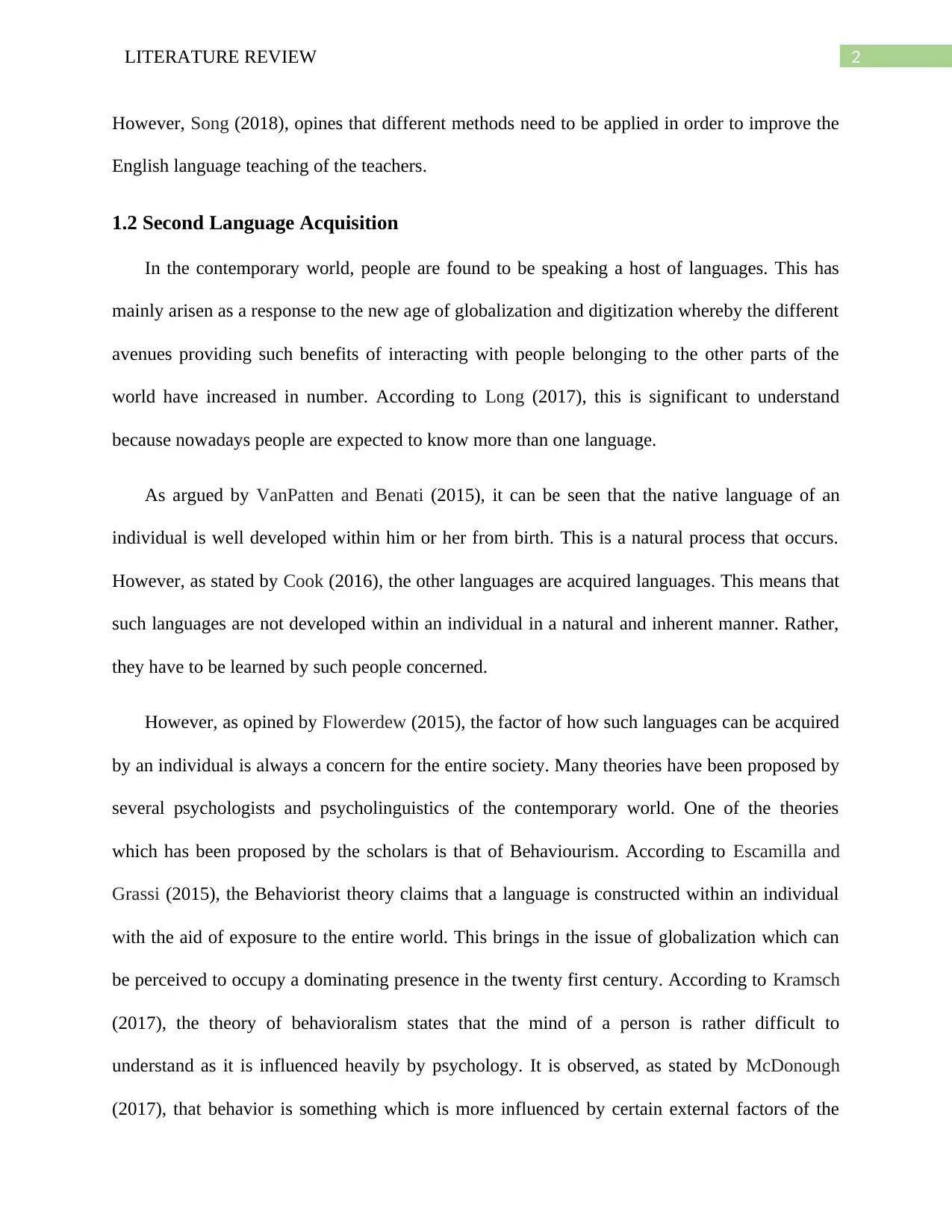
2LITERATURE REVIEW
However, Song (2018), opines that different methods need to be applied in order to improve the
English language teaching of the teachers.
1.2 Second Language Acquisition
In the contemporary world, people are found to be speaking a host of languages. This has
mainly arisen as a response to the new age of globalization and digitization whereby the different
avenues providing such benefits of interacting with people belonging to the other parts of the
world have increased in number. According to Long (2017), this is significant to understand
because nowadays people are expected to know more than one language.
As argued by VanPatten and Benati (2015), it can be seen that the native language of an
individual is well developed within him or her from birth. This is a natural process that occurs.
However, as stated by Cook (2016), the other languages are acquired languages. This means that
such languages are not developed within an individual in a natural and inherent manner. Rather,
they have to be learned by such people concerned.
However, as opined by Flowerdew (2015), the factor of how such languages can be acquired
by an individual is always a concern for the entire society. Many theories have been proposed by
several psychologists and psycholinguistics of the contemporary world. One of the theories
which has been proposed by the scholars is that of Behaviourism. According to Escamilla and
Grassi (2015), the Behaviorist theory claims that a language is constructed within an individual
with the aid of exposure to the entire world. This brings in the issue of globalization which can
be perceived to occupy a dominating presence in the twenty first century. According to Kramsch
(2017), the theory of behavioralism states that the mind of a person is rather difficult to
understand as it is influenced heavily by psychology. It is observed, as stated by McDonough
(2017), that behavior is something which is more influenced by certain external factors of the
However, Song (2018), opines that different methods need to be applied in order to improve the
English language teaching of the teachers.
1.2 Second Language Acquisition
In the contemporary world, people are found to be speaking a host of languages. This has
mainly arisen as a response to the new age of globalization and digitization whereby the different
avenues providing such benefits of interacting with people belonging to the other parts of the
world have increased in number. According to Long (2017), this is significant to understand
because nowadays people are expected to know more than one language.
As argued by VanPatten and Benati (2015), it can be seen that the native language of an
individual is well developed within him or her from birth. This is a natural process that occurs.
However, as stated by Cook (2016), the other languages are acquired languages. This means that
such languages are not developed within an individual in a natural and inherent manner. Rather,
they have to be learned by such people concerned.
However, as opined by Flowerdew (2015), the factor of how such languages can be acquired
by an individual is always a concern for the entire society. Many theories have been proposed by
several psychologists and psycholinguistics of the contemporary world. One of the theories
which has been proposed by the scholars is that of Behaviourism. According to Escamilla and
Grassi (2015), the Behaviorist theory claims that a language is constructed within an individual
with the aid of exposure to the entire world. This brings in the issue of globalization which can
be perceived to occupy a dominating presence in the twenty first century. According to Kramsch
(2017), the theory of behavioralism states that the mind of a person is rather difficult to
understand as it is influenced heavily by psychology. It is observed, as stated by McDonough
(2017), that behavior is something which is more influenced by certain external factors of the
⊘ This is a preview!⊘
Do you want full access?
Subscribe today to unlock all pages.

Trusted by 1+ million students worldwide
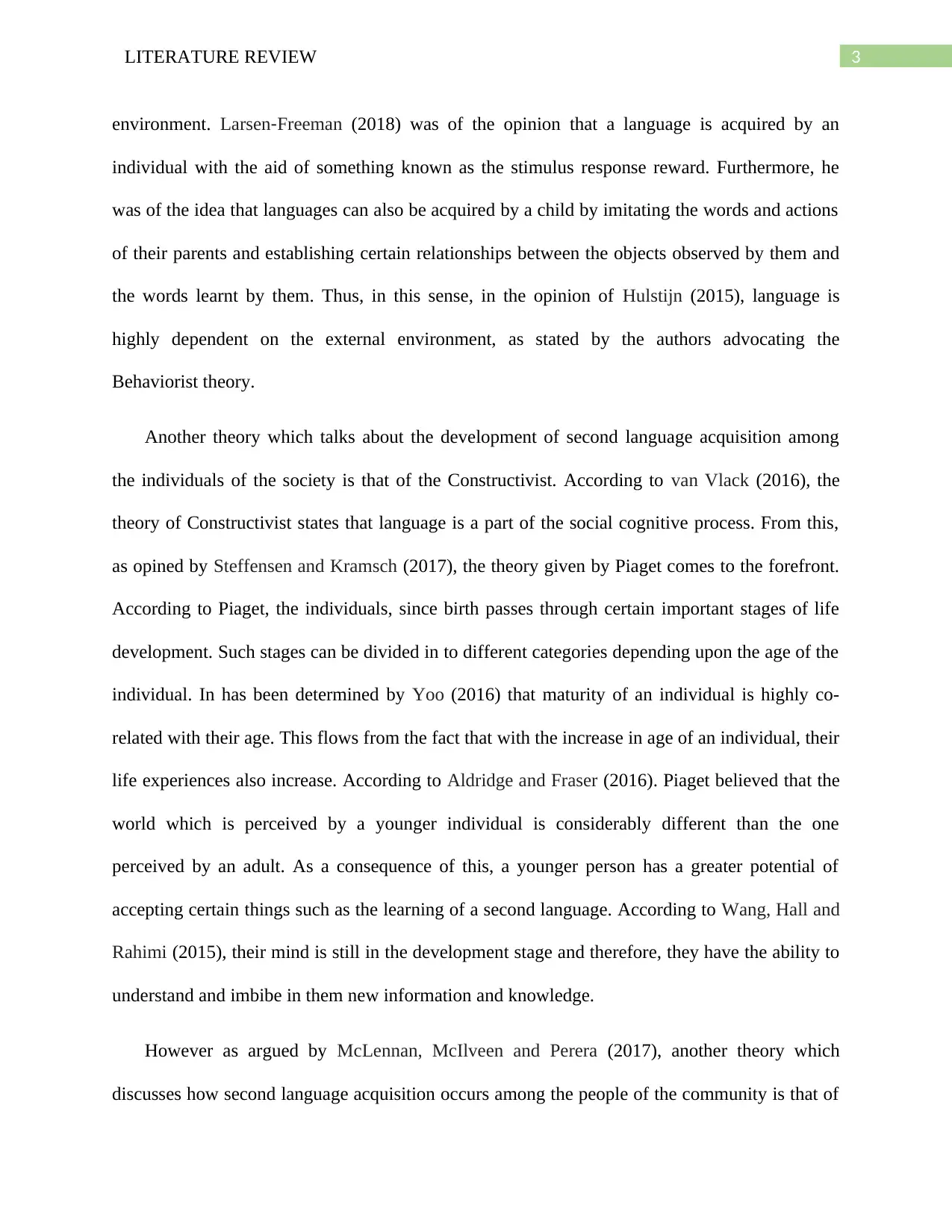
3LITERATURE REVIEW
environment. Larsen‐Freeman (2018) was of the opinion that a language is acquired by an
individual with the aid of something known as the stimulus response reward. Furthermore, he
was of the idea that languages can also be acquired by a child by imitating the words and actions
of their parents and establishing certain relationships between the objects observed by them and
the words learnt by them. Thus, in this sense, in the opinion of Hulstijn (2015), language is
highly dependent on the external environment, as stated by the authors advocating the
Behaviorist theory.
Another theory which talks about the development of second language acquisition among
the individuals of the society is that of the Constructivist. According to van Vlack (2016), the
theory of Constructivist states that language is a part of the social cognitive process. From this,
as opined by Steffensen and Kramsch (2017), the theory given by Piaget comes to the forefront.
According to Piaget, the individuals, since birth passes through certain important stages of life
development. Such stages can be divided in to different categories depending upon the age of the
individual. In has been determined by Yoo (2016) that maturity of an individual is highly co-
related with their age. This flows from the fact that with the increase in age of an individual, their
life experiences also increase. According to Aldridge and Fraser (2016). Piaget believed that the
world which is perceived by a younger individual is considerably different than the one
perceived by an adult. As a consequence of this, a younger person has a greater potential of
accepting certain things such as the learning of a second language. According to Wang, Hall and
Rahimi (2015), their mind is still in the development stage and therefore, they have the ability to
understand and imbibe in them new information and knowledge.
However as argued by McLennan, McIlveen and Perera (2017), another theory which
discusses how second language acquisition occurs among the people of the community is that of
environment. Larsen‐Freeman (2018) was of the opinion that a language is acquired by an
individual with the aid of something known as the stimulus response reward. Furthermore, he
was of the idea that languages can also be acquired by a child by imitating the words and actions
of their parents and establishing certain relationships between the objects observed by them and
the words learnt by them. Thus, in this sense, in the opinion of Hulstijn (2015), language is
highly dependent on the external environment, as stated by the authors advocating the
Behaviorist theory.
Another theory which talks about the development of second language acquisition among
the individuals of the society is that of the Constructivist. According to van Vlack (2016), the
theory of Constructivist states that language is a part of the social cognitive process. From this,
as opined by Steffensen and Kramsch (2017), the theory given by Piaget comes to the forefront.
According to Piaget, the individuals, since birth passes through certain important stages of life
development. Such stages can be divided in to different categories depending upon the age of the
individual. In has been determined by Yoo (2016) that maturity of an individual is highly co-
related with their age. This flows from the fact that with the increase in age of an individual, their
life experiences also increase. According to Aldridge and Fraser (2016). Piaget believed that the
world which is perceived by a younger individual is considerably different than the one
perceived by an adult. As a consequence of this, a younger person has a greater potential of
accepting certain things such as the learning of a second language. According to Wang, Hall and
Rahimi (2015), their mind is still in the development stage and therefore, they have the ability to
understand and imbibe in them new information and knowledge.
However as argued by McLennan, McIlveen and Perera (2017), another theory which
discusses how second language acquisition occurs among the people of the community is that of
Paraphrase This Document
Need a fresh take? Get an instant paraphrase of this document with our AI Paraphraser
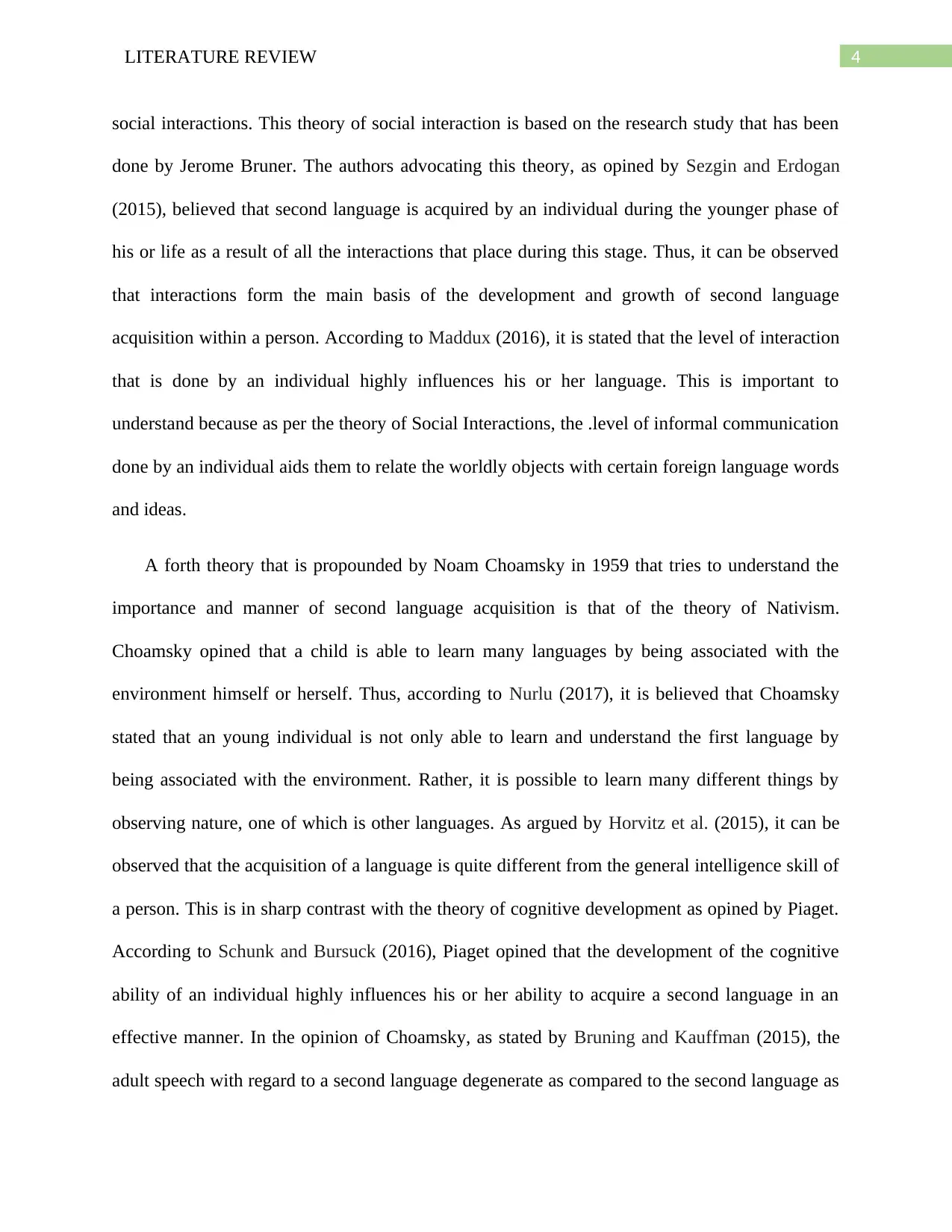
4LITERATURE REVIEW
social interactions. This theory of social interaction is based on the research study that has been
done by Jerome Bruner. The authors advocating this theory, as opined by Sezgin and Erdogan
(2015), believed that second language is acquired by an individual during the younger phase of
his or life as a result of all the interactions that place during this stage. Thus, it can be observed
that interactions form the main basis of the development and growth of second language
acquisition within a person. According to Maddux (2016), it is stated that the level of interaction
that is done by an individual highly influences his or her language. This is important to
understand because as per the theory of Social Interactions, the .level of informal communication
done by an individual aids them to relate the worldly objects with certain foreign language words
and ideas.
A forth theory that is propounded by Noam Choamsky in 1959 that tries to understand the
importance and manner of second language acquisition is that of the theory of Nativism.
Choamsky opined that a child is able to learn many languages by being associated with the
environment himself or herself. Thus, according to Nurlu (2017), it is believed that Choamsky
stated that an young individual is not only able to learn and understand the first language by
being associated with the environment. Rather, it is possible to learn many different things by
observing nature, one of which is other languages. As argued by Horvitz et al. (2015), it can be
observed that the acquisition of a language is quite different from the general intelligence skill of
a person. This is in sharp contrast with the theory of cognitive development as opined by Piaget.
According to Schunk and Bursuck (2016), Piaget opined that the development of the cognitive
ability of an individual highly influences his or her ability to acquire a second language in an
effective manner. In the opinion of Choamsky, as stated by Bruning and Kauffman (2015), the
adult speech with regard to a second language degenerate as compared to the second language as
social interactions. This theory of social interaction is based on the research study that has been
done by Jerome Bruner. The authors advocating this theory, as opined by Sezgin and Erdogan
(2015), believed that second language is acquired by an individual during the younger phase of
his or life as a result of all the interactions that place during this stage. Thus, it can be observed
that interactions form the main basis of the development and growth of second language
acquisition within a person. According to Maddux (2016), it is stated that the level of interaction
that is done by an individual highly influences his or her language. This is important to
understand because as per the theory of Social Interactions, the .level of informal communication
done by an individual aids them to relate the worldly objects with certain foreign language words
and ideas.
A forth theory that is propounded by Noam Choamsky in 1959 that tries to understand the
importance and manner of second language acquisition is that of the theory of Nativism.
Choamsky opined that a child is able to learn many languages by being associated with the
environment himself or herself. Thus, according to Nurlu (2017), it is believed that Choamsky
stated that an young individual is not only able to learn and understand the first language by
being associated with the environment. Rather, it is possible to learn many different things by
observing nature, one of which is other languages. As argued by Horvitz et al. (2015), it can be
observed that the acquisition of a language is quite different from the general intelligence skill of
a person. This is in sharp contrast with the theory of cognitive development as opined by Piaget.
According to Schunk and Bursuck (2016), Piaget opined that the development of the cognitive
ability of an individual highly influences his or her ability to acquire a second language in an
effective manner. In the opinion of Choamsky, as stated by Bruning and Kauffman (2015), the
adult speech with regard to a second language degenerate as compared to the second language as
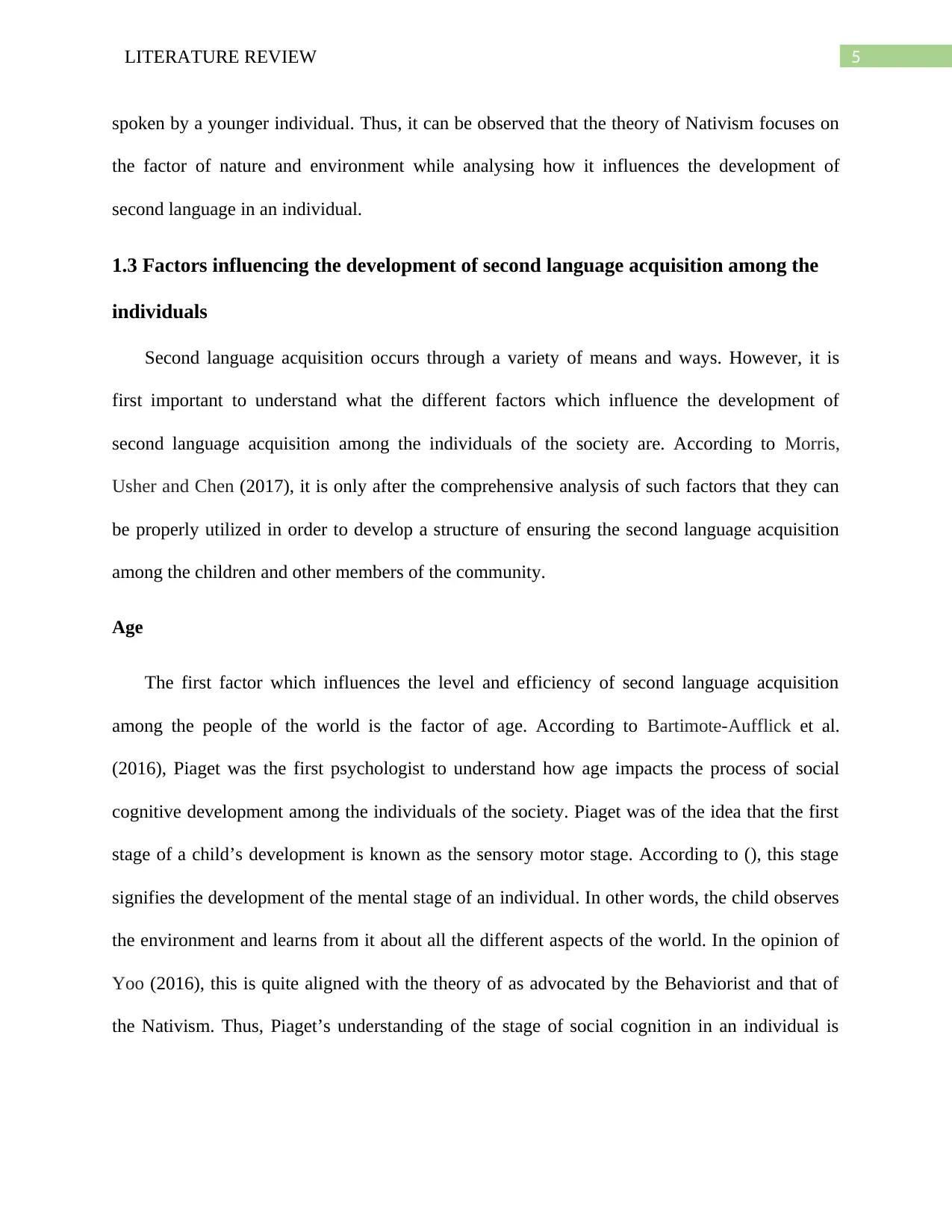
5LITERATURE REVIEW
spoken by a younger individual. Thus, it can be observed that the theory of Nativism focuses on
the factor of nature and environment while analysing how it influences the development of
second language in an individual.
1.3 Factors influencing the development of second language acquisition among the
individuals
Second language acquisition occurs through a variety of means and ways. However, it is
first important to understand what the different factors which influence the development of
second language acquisition among the individuals of the society are. According to Morris,
Usher and Chen (2017), it is only after the comprehensive analysis of such factors that they can
be properly utilized in order to develop a structure of ensuring the second language acquisition
among the children and other members of the community.
Age
The first factor which influences the level and efficiency of second language acquisition
among the people of the world is the factor of age. According to Bartimote-Aufflick et al.
(2016), Piaget was the first psychologist to understand how age impacts the process of social
cognitive development among the individuals of the society. Piaget was of the idea that the first
stage of a child’s development is known as the sensory motor stage. According to (), this stage
signifies the development of the mental stage of an individual. In other words, the child observes
the environment and learns from it about all the different aspects of the world. In the opinion of
Yoo (2016), this is quite aligned with the theory of as advocated by the Behaviorist and that of
the Nativism. Thus, Piaget’s understanding of the stage of social cognition in an individual is
spoken by a younger individual. Thus, it can be observed that the theory of Nativism focuses on
the factor of nature and environment while analysing how it influences the development of
second language in an individual.
1.3 Factors influencing the development of second language acquisition among the
individuals
Second language acquisition occurs through a variety of means and ways. However, it is
first important to understand what the different factors which influence the development of
second language acquisition among the individuals of the society are. According to Morris,
Usher and Chen (2017), it is only after the comprehensive analysis of such factors that they can
be properly utilized in order to develop a structure of ensuring the second language acquisition
among the children and other members of the community.
Age
The first factor which influences the level and efficiency of second language acquisition
among the people of the world is the factor of age. According to Bartimote-Aufflick et al.
(2016), Piaget was the first psychologist to understand how age impacts the process of social
cognitive development among the individuals of the society. Piaget was of the idea that the first
stage of a child’s development is known as the sensory motor stage. According to (), this stage
signifies the development of the mental stage of an individual. In other words, the child observes
the environment and learns from it about all the different aspects of the world. In the opinion of
Yoo (2016), this is quite aligned with the theory of as advocated by the Behaviorist and that of
the Nativism. Thus, Piaget’s understanding of the stage of social cognition in an individual is
⊘ This is a preview!⊘
Do you want full access?
Subscribe today to unlock all pages.

Trusted by 1+ million students worldwide
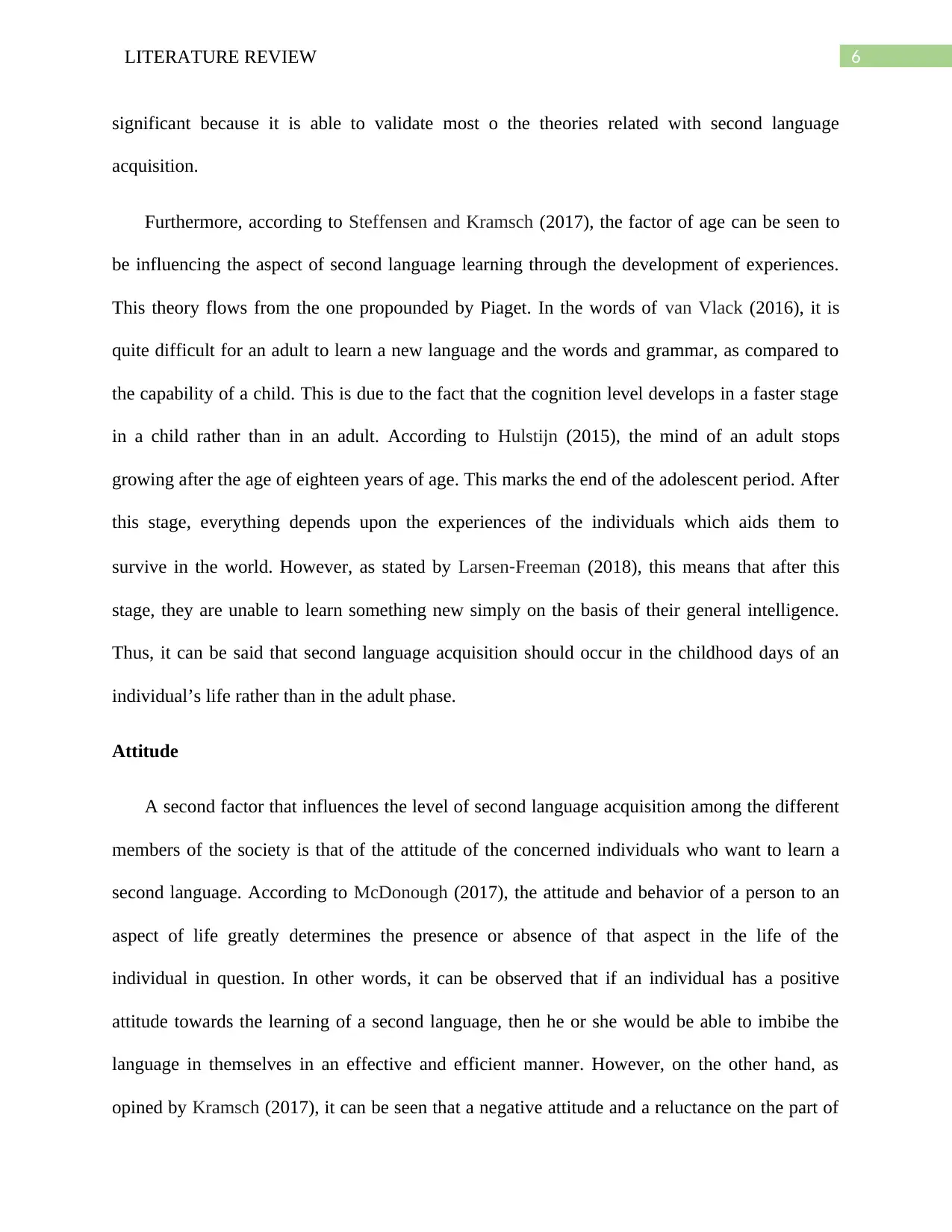
6LITERATURE REVIEW
significant because it is able to validate most o the theories related with second language
acquisition.
Furthermore, according to Steffensen and Kramsch (2017), the factor of age can be seen to
be influencing the aspect of second language learning through the development of experiences.
This theory flows from the one propounded by Piaget. In the words of van Vlack (2016), it is
quite difficult for an adult to learn a new language and the words and grammar, as compared to
the capability of a child. This is due to the fact that the cognition level develops in a faster stage
in a child rather than in an adult. According to Hulstijn (2015), the mind of an adult stops
growing after the age of eighteen years of age. This marks the end of the adolescent period. After
this stage, everything depends upon the experiences of the individuals which aids them to
survive in the world. However, as stated by Larsen‐Freeman (2018), this means that after this
stage, they are unable to learn something new simply on the basis of their general intelligence.
Thus, it can be said that second language acquisition should occur in the childhood days of an
individual’s life rather than in the adult phase.
Attitude
A second factor that influences the level of second language acquisition among the different
members of the society is that of the attitude of the concerned individuals who want to learn a
second language. According to McDonough (2017), the attitude and behavior of a person to an
aspect of life greatly determines the presence or absence of that aspect in the life of the
individual in question. In other words, it can be observed that if an individual has a positive
attitude towards the learning of a second language, then he or she would be able to imbibe the
language in themselves in an effective and efficient manner. However, on the other hand, as
opined by Kramsch (2017), it can be seen that a negative attitude and a reluctance on the part of
significant because it is able to validate most o the theories related with second language
acquisition.
Furthermore, according to Steffensen and Kramsch (2017), the factor of age can be seen to
be influencing the aspect of second language learning through the development of experiences.
This theory flows from the one propounded by Piaget. In the words of van Vlack (2016), it is
quite difficult for an adult to learn a new language and the words and grammar, as compared to
the capability of a child. This is due to the fact that the cognition level develops in a faster stage
in a child rather than in an adult. According to Hulstijn (2015), the mind of an adult stops
growing after the age of eighteen years of age. This marks the end of the adolescent period. After
this stage, everything depends upon the experiences of the individuals which aids them to
survive in the world. However, as stated by Larsen‐Freeman (2018), this means that after this
stage, they are unable to learn something new simply on the basis of their general intelligence.
Thus, it can be said that second language acquisition should occur in the childhood days of an
individual’s life rather than in the adult phase.
Attitude
A second factor that influences the level of second language acquisition among the different
members of the society is that of the attitude of the concerned individuals who want to learn a
second language. According to McDonough (2017), the attitude and behavior of a person to an
aspect of life greatly determines the presence or absence of that aspect in the life of the
individual in question. In other words, it can be observed that if an individual has a positive
attitude towards the learning of a second language, then he or she would be able to imbibe the
language in themselves in an effective and efficient manner. However, on the other hand, as
opined by Kramsch (2017), it can be seen that a negative attitude and a reluctance on the part of
Paraphrase This Document
Need a fresh take? Get an instant paraphrase of this document with our AI Paraphraser
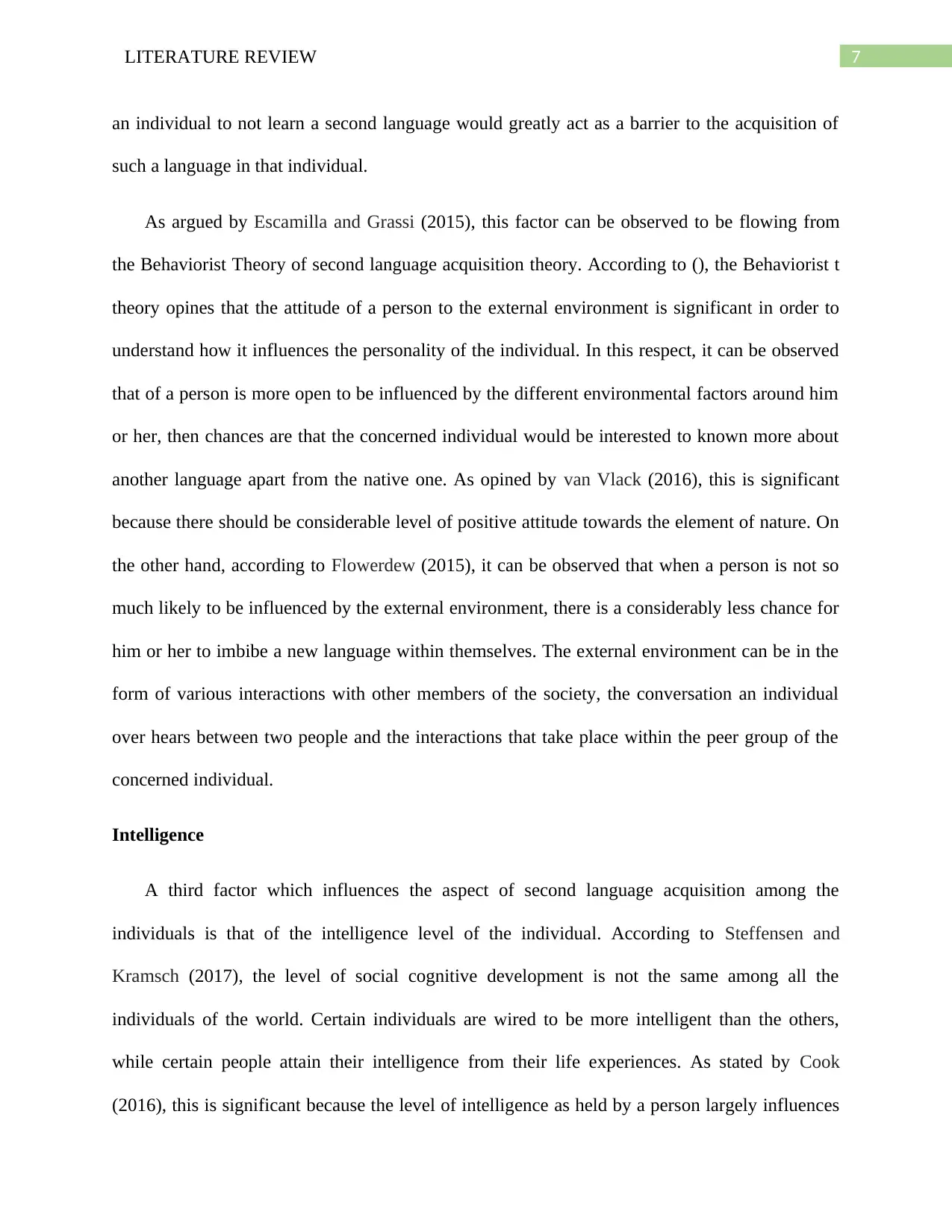
7LITERATURE REVIEW
an individual to not learn a second language would greatly act as a barrier to the acquisition of
such a language in that individual.
As argued by Escamilla and Grassi (2015), this factor can be observed to be flowing from
the Behaviorist Theory of second language acquisition theory. According to (), the Behaviorist t
theory opines that the attitude of a person to the external environment is significant in order to
understand how it influences the personality of the individual. In this respect, it can be observed
that of a person is more open to be influenced by the different environmental factors around him
or her, then chances are that the concerned individual would be interested to known more about
another language apart from the native one. As opined by van Vlack (2016), this is significant
because there should be considerable level of positive attitude towards the element of nature. On
the other hand, according to Flowerdew (2015), it can be observed that when a person is not so
much likely to be influenced by the external environment, there is a considerably less chance for
him or her to imbibe a new language within themselves. The external environment can be in the
form of various interactions with other members of the society, the conversation an individual
over hears between two people and the interactions that take place within the peer group of the
concerned individual.
Intelligence
A third factor which influences the aspect of second language acquisition among the
individuals is that of the intelligence level of the individual. According to Steffensen and
Kramsch (2017), the level of social cognitive development is not the same among all the
individuals of the world. Certain individuals are wired to be more intelligent than the others,
while certain people attain their intelligence from their life experiences. As stated by Cook
(2016), this is significant because the level of intelligence as held by a person largely influences
an individual to not learn a second language would greatly act as a barrier to the acquisition of
such a language in that individual.
As argued by Escamilla and Grassi (2015), this factor can be observed to be flowing from
the Behaviorist Theory of second language acquisition theory. According to (), the Behaviorist t
theory opines that the attitude of a person to the external environment is significant in order to
understand how it influences the personality of the individual. In this respect, it can be observed
that of a person is more open to be influenced by the different environmental factors around him
or her, then chances are that the concerned individual would be interested to known more about
another language apart from the native one. As opined by van Vlack (2016), this is significant
because there should be considerable level of positive attitude towards the element of nature. On
the other hand, according to Flowerdew (2015), it can be observed that when a person is not so
much likely to be influenced by the external environment, there is a considerably less chance for
him or her to imbibe a new language within themselves. The external environment can be in the
form of various interactions with other members of the society, the conversation an individual
over hears between two people and the interactions that take place within the peer group of the
concerned individual.
Intelligence
A third factor which influences the aspect of second language acquisition among the
individuals is that of the intelligence level of the individual. According to Steffensen and
Kramsch (2017), the level of social cognitive development is not the same among all the
individuals of the world. Certain individuals are wired to be more intelligent than the others,
while certain people attain their intelligence from their life experiences. As stated by Cook
(2016), this is significant because the level of intelligence as held by a person largely influences
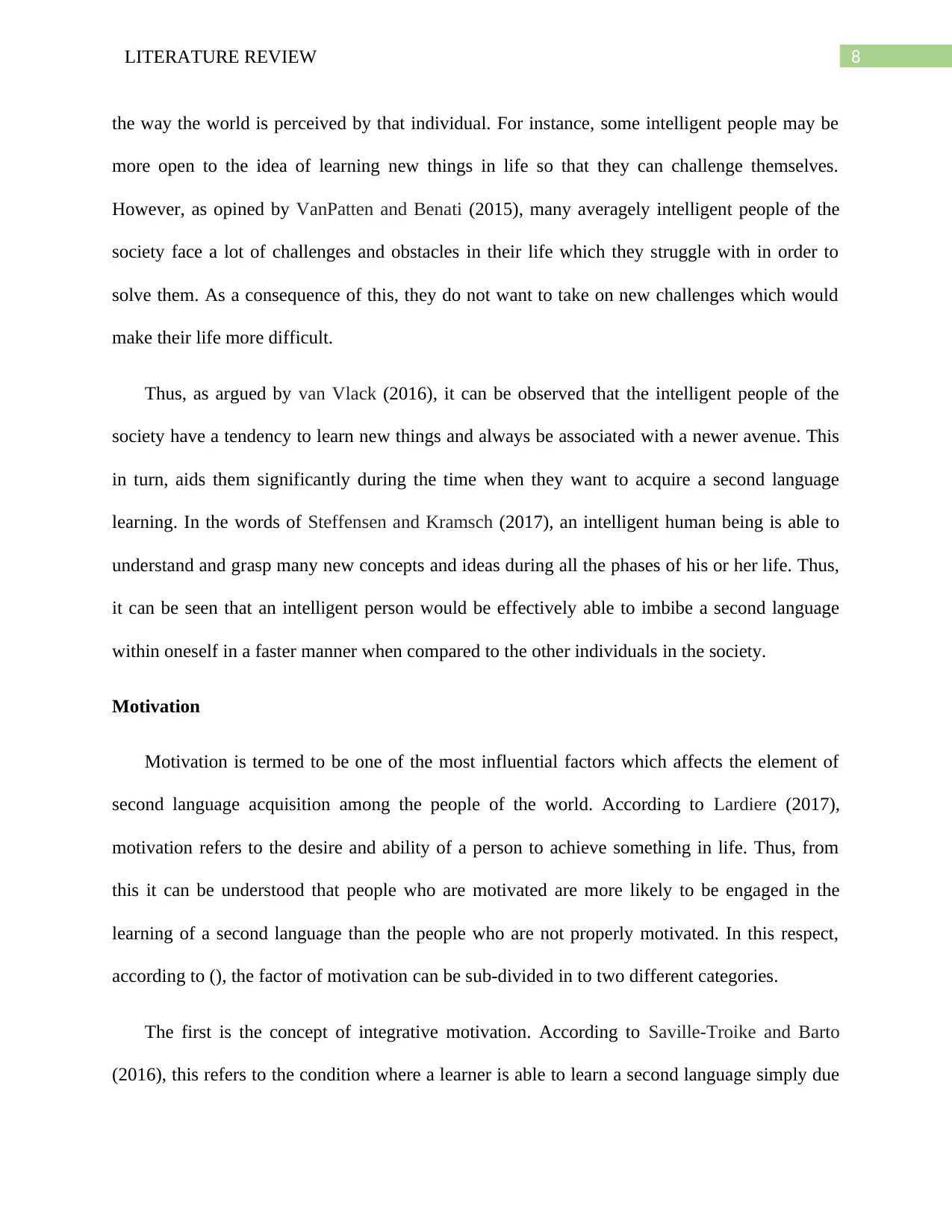
8LITERATURE REVIEW
the way the world is perceived by that individual. For instance, some intelligent people may be
more open to the idea of learning new things in life so that they can challenge themselves.
However, as opined by VanPatten and Benati (2015), many averagely intelligent people of the
society face a lot of challenges and obstacles in their life which they struggle with in order to
solve them. As a consequence of this, they do not want to take on new challenges which would
make their life more difficult.
Thus, as argued by van Vlack (2016), it can be observed that the intelligent people of the
society have a tendency to learn new things and always be associated with a newer avenue. This
in turn, aids them significantly during the time when they want to acquire a second language
learning. In the words of Steffensen and Kramsch (2017), an intelligent human being is able to
understand and grasp many new concepts and ideas during all the phases of his or her life. Thus,
it can be seen that an intelligent person would be effectively able to imbibe a second language
within oneself in a faster manner when compared to the other individuals in the society.
Motivation
Motivation is termed to be one of the most influential factors which affects the element of
second language acquisition among the people of the world. According to Lardiere (2017),
motivation refers to the desire and ability of a person to achieve something in life. Thus, from
this it can be understood that people who are motivated are more likely to be engaged in the
learning of a second language than the people who are not properly motivated. In this respect,
according to (), the factor of motivation can be sub-divided in to two different categories.
The first is the concept of integrative motivation. According to Saville-Troike and Barto
(2016), this refers to the condition where a learner is able to learn a second language simply due
the way the world is perceived by that individual. For instance, some intelligent people may be
more open to the idea of learning new things in life so that they can challenge themselves.
However, as opined by VanPatten and Benati (2015), many averagely intelligent people of the
society face a lot of challenges and obstacles in their life which they struggle with in order to
solve them. As a consequence of this, they do not want to take on new challenges which would
make their life more difficult.
Thus, as argued by van Vlack (2016), it can be observed that the intelligent people of the
society have a tendency to learn new things and always be associated with a newer avenue. This
in turn, aids them significantly during the time when they want to acquire a second language
learning. In the words of Steffensen and Kramsch (2017), an intelligent human being is able to
understand and grasp many new concepts and ideas during all the phases of his or her life. Thus,
it can be seen that an intelligent person would be effectively able to imbibe a second language
within oneself in a faster manner when compared to the other individuals in the society.
Motivation
Motivation is termed to be one of the most influential factors which affects the element of
second language acquisition among the people of the world. According to Lardiere (2017),
motivation refers to the desire and ability of a person to achieve something in life. Thus, from
this it can be understood that people who are motivated are more likely to be engaged in the
learning of a second language than the people who are not properly motivated. In this respect,
according to (), the factor of motivation can be sub-divided in to two different categories.
The first is the concept of integrative motivation. According to Saville-Troike and Barto
(2016), this refers to the condition where a learner is able to learn a second language simply due
⊘ This is a preview!⊘
Do you want full access?
Subscribe today to unlock all pages.

Trusted by 1+ million students worldwide
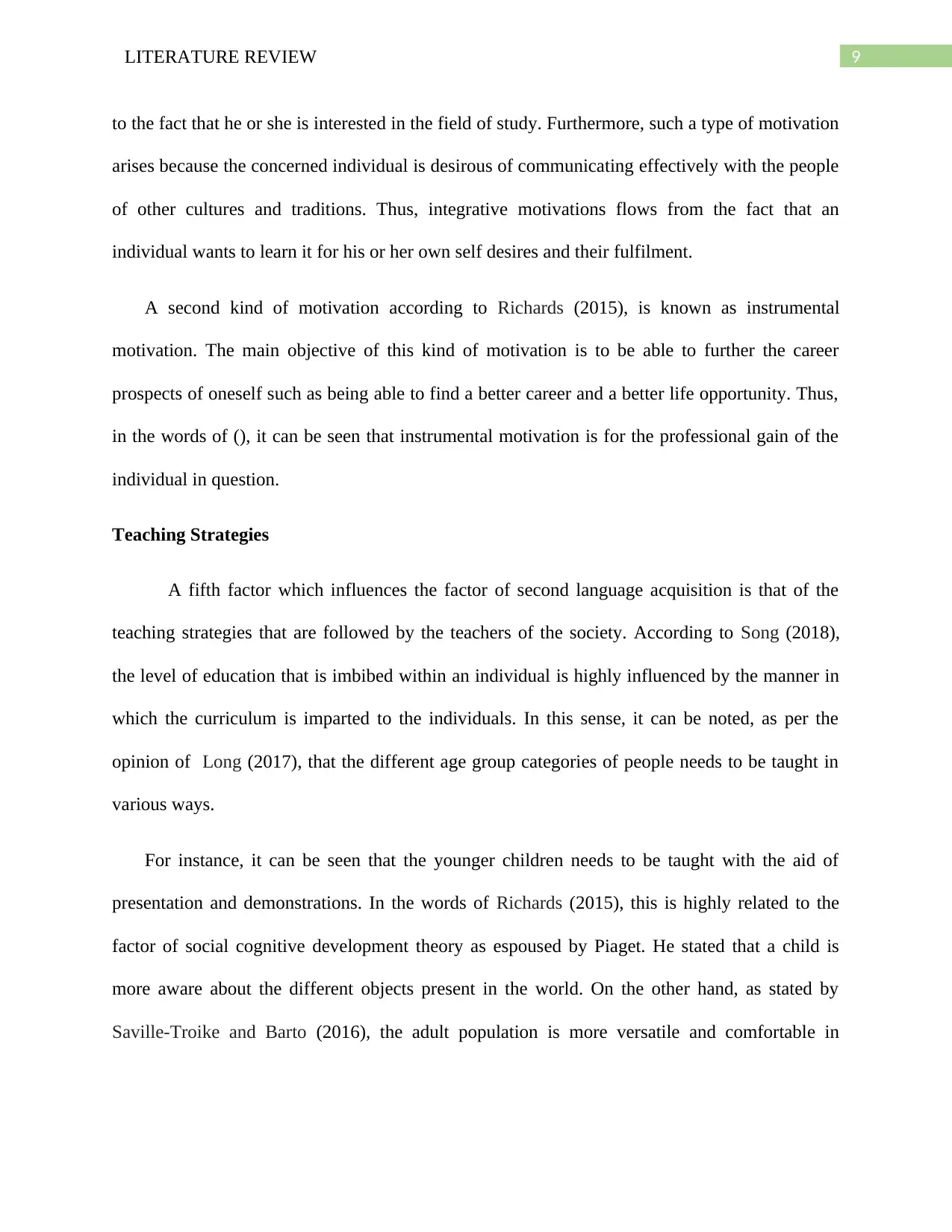
9LITERATURE REVIEW
to the fact that he or she is interested in the field of study. Furthermore, such a type of motivation
arises because the concerned individual is desirous of communicating effectively with the people
of other cultures and traditions. Thus, integrative motivations flows from the fact that an
individual wants to learn it for his or her own self desires and their fulfilment.
A second kind of motivation according to Richards (2015), is known as instrumental
motivation. The main objective of this kind of motivation is to be able to further the career
prospects of oneself such as being able to find a better career and a better life opportunity. Thus,
in the words of (), it can be seen that instrumental motivation is for the professional gain of the
individual in question.
Teaching Strategies
A fifth factor which influences the factor of second language acquisition is that of the
teaching strategies that are followed by the teachers of the society. According to Song (2018),
the level of education that is imbibed within an individual is highly influenced by the manner in
which the curriculum is imparted to the individuals. In this sense, it can be noted, as per the
opinion of Long (2017), that the different age group categories of people needs to be taught in
various ways.
For instance, it can be seen that the younger children needs to be taught with the aid of
presentation and demonstrations. In the words of Richards (2015), this is highly related to the
factor of social cognitive development theory as espoused by Piaget. He stated that a child is
more aware about the different objects present in the world. On the other hand, as stated by
Saville-Troike and Barto (2016), the adult population is more versatile and comfortable in
to the fact that he or she is interested in the field of study. Furthermore, such a type of motivation
arises because the concerned individual is desirous of communicating effectively with the people
of other cultures and traditions. Thus, integrative motivations flows from the fact that an
individual wants to learn it for his or her own self desires and their fulfilment.
A second kind of motivation according to Richards (2015), is known as instrumental
motivation. The main objective of this kind of motivation is to be able to further the career
prospects of oneself such as being able to find a better career and a better life opportunity. Thus,
in the words of (), it can be seen that instrumental motivation is for the professional gain of the
individual in question.
Teaching Strategies
A fifth factor which influences the factor of second language acquisition is that of the
teaching strategies that are followed by the teachers of the society. According to Song (2018),
the level of education that is imbibed within an individual is highly influenced by the manner in
which the curriculum is imparted to the individuals. In this sense, it can be noted, as per the
opinion of Long (2017), that the different age group categories of people needs to be taught in
various ways.
For instance, it can be seen that the younger children needs to be taught with the aid of
presentation and demonstrations. In the words of Richards (2015), this is highly related to the
factor of social cognitive development theory as espoused by Piaget. He stated that a child is
more aware about the different objects present in the world. On the other hand, as stated by
Saville-Troike and Barto (2016), the adult population is more versatile and comfortable in
Paraphrase This Document
Need a fresh take? Get an instant paraphrase of this document with our AI Paraphraser
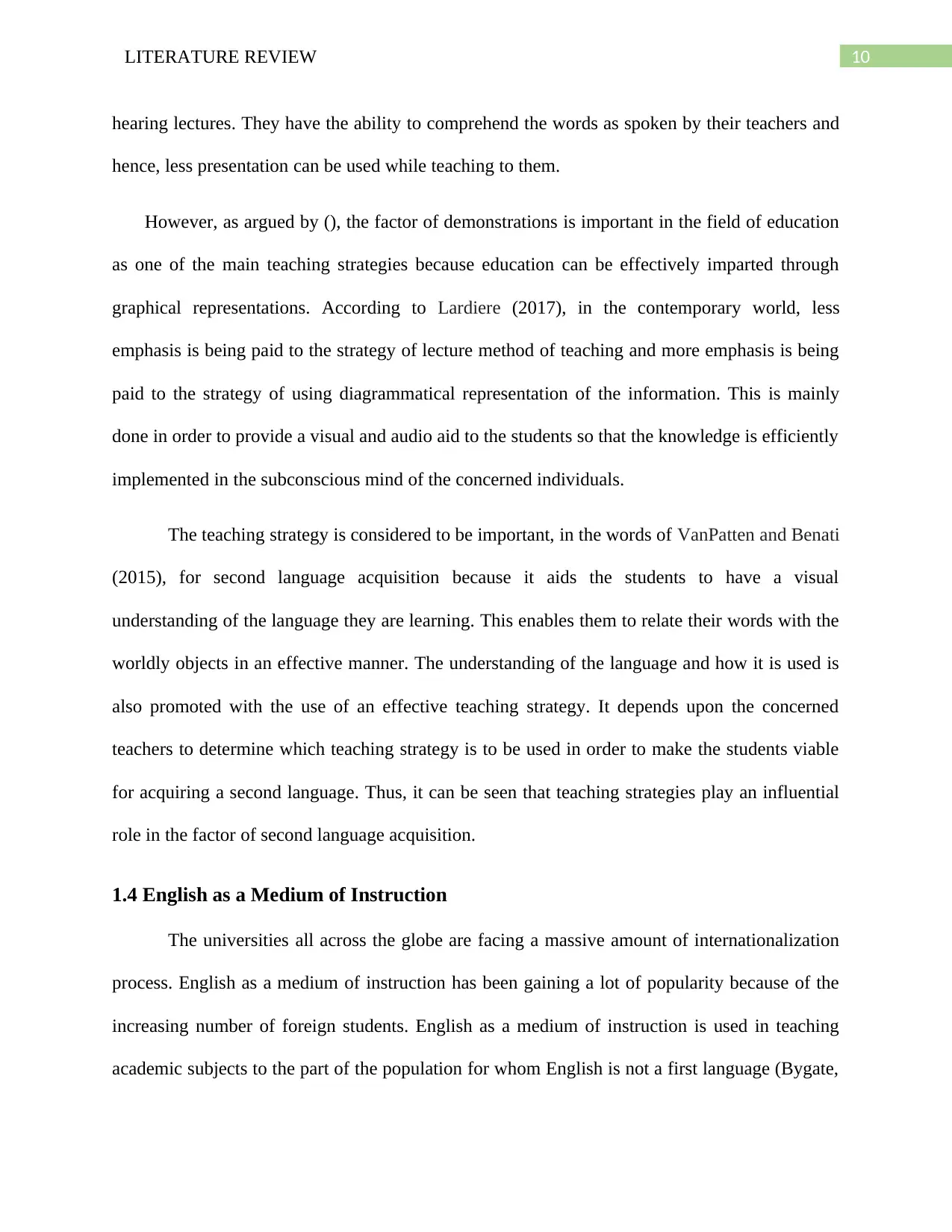
10LITERATURE REVIEW
hearing lectures. They have the ability to comprehend the words as spoken by their teachers and
hence, less presentation can be used while teaching to them.
However, as argued by (), the factor of demonstrations is important in the field of education
as one of the main teaching strategies because education can be effectively imparted through
graphical representations. According to Lardiere (2017), in the contemporary world, less
emphasis is being paid to the strategy of lecture method of teaching and more emphasis is being
paid to the strategy of using diagrammatical representation of the information. This is mainly
done in order to provide a visual and audio aid to the students so that the knowledge is efficiently
implemented in the subconscious mind of the concerned individuals.
The teaching strategy is considered to be important, in the words of VanPatten and Benati
(2015), for second language acquisition because it aids the students to have a visual
understanding of the language they are learning. This enables them to relate their words with the
worldly objects in an effective manner. The understanding of the language and how it is used is
also promoted with the use of an effective teaching strategy. It depends upon the concerned
teachers to determine which teaching strategy is to be used in order to make the students viable
for acquiring a second language. Thus, it can be seen that teaching strategies play an influential
role in the factor of second language acquisition.
1.4 English as a Medium of Instruction
The universities all across the globe are facing a massive amount of internationalization
process. English as a medium of instruction has been gaining a lot of popularity because of the
increasing number of foreign students. English as a medium of instruction is used in teaching
academic subjects to the part of the population for whom English is not a first language (Bygate,
hearing lectures. They have the ability to comprehend the words as spoken by their teachers and
hence, less presentation can be used while teaching to them.
However, as argued by (), the factor of demonstrations is important in the field of education
as one of the main teaching strategies because education can be effectively imparted through
graphical representations. According to Lardiere (2017), in the contemporary world, less
emphasis is being paid to the strategy of lecture method of teaching and more emphasis is being
paid to the strategy of using diagrammatical representation of the information. This is mainly
done in order to provide a visual and audio aid to the students so that the knowledge is efficiently
implemented in the subconscious mind of the concerned individuals.
The teaching strategy is considered to be important, in the words of VanPatten and Benati
(2015), for second language acquisition because it aids the students to have a visual
understanding of the language they are learning. This enables them to relate their words with the
worldly objects in an effective manner. The understanding of the language and how it is used is
also promoted with the use of an effective teaching strategy. It depends upon the concerned
teachers to determine which teaching strategy is to be used in order to make the students viable
for acquiring a second language. Thus, it can be seen that teaching strategies play an influential
role in the factor of second language acquisition.
1.4 English as a Medium of Instruction
The universities all across the globe are facing a massive amount of internationalization
process. English as a medium of instruction has been gaining a lot of popularity because of the
increasing number of foreign students. English as a medium of instruction is used in teaching
academic subjects to the part of the population for whom English is not a first language (Bygate,
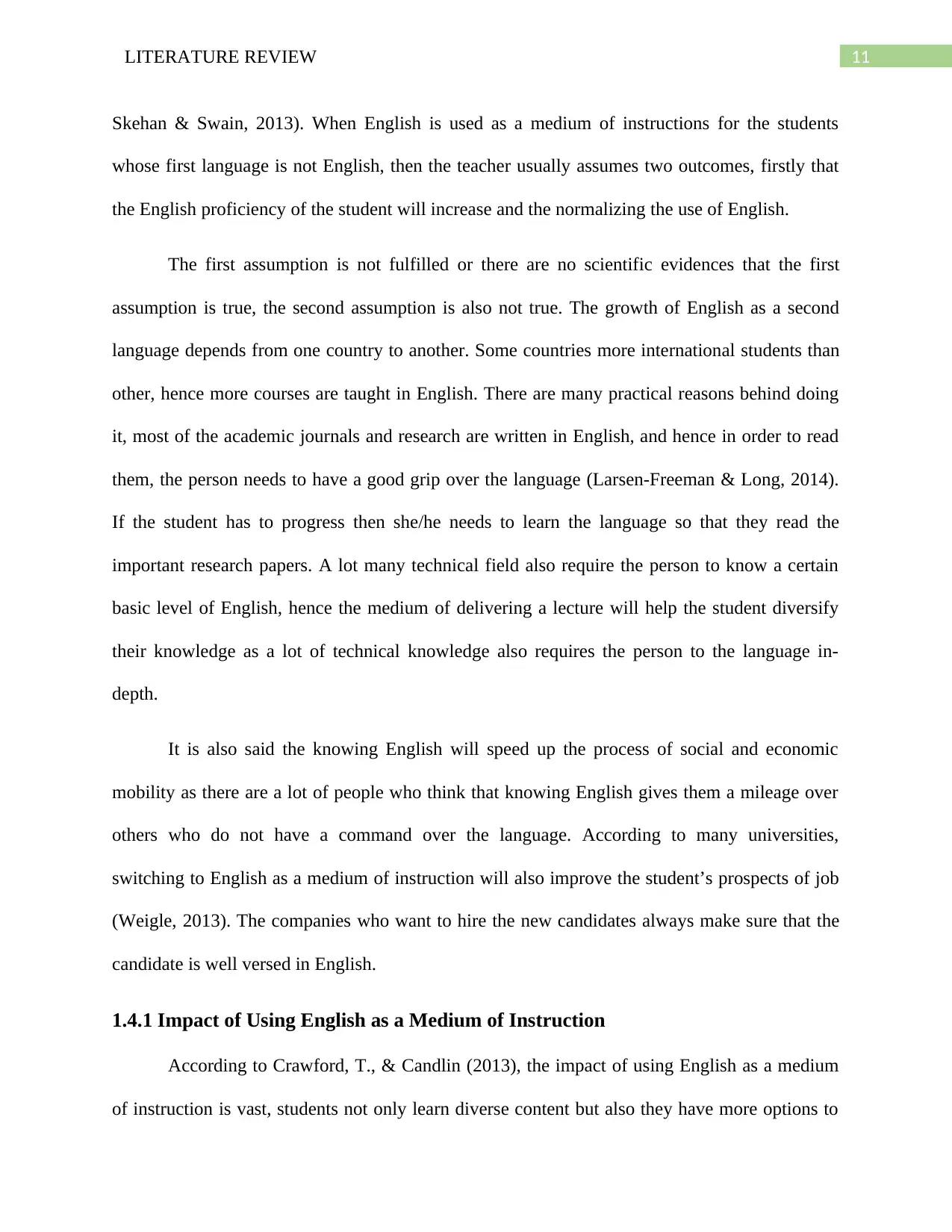
11LITERATURE REVIEW
Skehan & Swain, 2013). When English is used as a medium of instructions for the students
whose first language is not English, then the teacher usually assumes two outcomes, firstly that
the English proficiency of the student will increase and the normalizing the use of English.
The first assumption is not fulfilled or there are no scientific evidences that the first
assumption is true, the second assumption is also not true. The growth of English as a second
language depends from one country to another. Some countries more international students than
other, hence more courses are taught in English. There are many practical reasons behind doing
it, most of the academic journals and research are written in English, and hence in order to read
them, the person needs to have a good grip over the language (Larsen-Freeman & Long, 2014).
If the student has to progress then she/he needs to learn the language so that they read the
important research papers. A lot many technical field also require the person to know a certain
basic level of English, hence the medium of delivering a lecture will help the student diversify
their knowledge as a lot of technical knowledge also requires the person to the language in-
depth.
It is also said the knowing English will speed up the process of social and economic
mobility as there are a lot of people who think that knowing English gives them a mileage over
others who do not have a command over the language. According to many universities,
switching to English as a medium of instruction will also improve the student’s prospects of job
(Weigle, 2013). The companies who want to hire the new candidates always make sure that the
candidate is well versed in English.
1.4.1 Impact of Using English as a Medium of Instruction
According to Crawford, T., & Candlin (2013), the impact of using English as a medium
of instruction is vast, students not only learn diverse content but also they have more options to
Skehan & Swain, 2013). When English is used as a medium of instructions for the students
whose first language is not English, then the teacher usually assumes two outcomes, firstly that
the English proficiency of the student will increase and the normalizing the use of English.
The first assumption is not fulfilled or there are no scientific evidences that the first
assumption is true, the second assumption is also not true. The growth of English as a second
language depends from one country to another. Some countries more international students than
other, hence more courses are taught in English. There are many practical reasons behind doing
it, most of the academic journals and research are written in English, and hence in order to read
them, the person needs to have a good grip over the language (Larsen-Freeman & Long, 2014).
If the student has to progress then she/he needs to learn the language so that they read the
important research papers. A lot many technical field also require the person to know a certain
basic level of English, hence the medium of delivering a lecture will help the student diversify
their knowledge as a lot of technical knowledge also requires the person to the language in-
depth.
It is also said the knowing English will speed up the process of social and economic
mobility as there are a lot of people who think that knowing English gives them a mileage over
others who do not have a command over the language. According to many universities,
switching to English as a medium of instruction will also improve the student’s prospects of job
(Weigle, 2013). The companies who want to hire the new candidates always make sure that the
candidate is well versed in English.
1.4.1 Impact of Using English as a Medium of Instruction
According to Crawford, T., & Candlin (2013), the impact of using English as a medium
of instruction is vast, students not only learn diverse content but also they have more options to
⊘ This is a preview!⊘
Do you want full access?
Subscribe today to unlock all pages.

Trusted by 1+ million students worldwide
1 out of 43
Related Documents
Your All-in-One AI-Powered Toolkit for Academic Success.
+13062052269
info@desklib.com
Available 24*7 on WhatsApp / Email
![[object Object]](/_next/static/media/star-bottom.7253800d.svg)
Unlock your academic potential
Copyright © 2020–2025 A2Z Services. All Rights Reserved. Developed and managed by ZUCOL.




